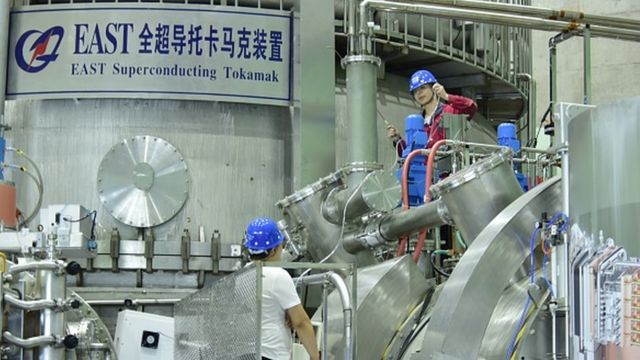The science news of the week:
Another very important step has been taken toward controlled thermonuclear fusion. According to scientists from the Institute of Plasma Physics at the Chinese Academy of Sciences, the EAST (Experimental Advanced Superconducting Tokamak) device succeeded in heating plasma to 120 million degrees Celsius and keeping it there for 1056 seconds, beating the previous record of 390 seconds set by the French on their own tokamak in 2003.
Why do we need to know about these fleeting moments and fantastic temperatures? Because nuclear fusion in a tokamak is literally a cosmic process that reproduces what happens in the heart of a star, where under the influence of extreme pressures and temperatures, the fusion of atomic nuclei occurs, resulting in the creation of new elements. In the case of main-sequence stars, their primary and only source of energy is hydrogen, whose nuclei fuse in thermonuclear fusion reactions to form helium. However, since each helium nucleus is less massive than four hydrogen nuclei from which it is derived, the excess energy is released in the form of light and heat, in strict accordance with the laws of physics. The amount of energy generated is enormous, literally enough to ignite stars. It is not surprising that scientists dream of controlling such a process under domestic conditions. There are several technologies to replicate the process of nuclear fusion, and one of them is the tokamak – a toroidal chamber with magnetic coils developed and built by Soviet scientists in the early 1950s.
We explain quickly, simply, and clearly what happened, why it matters, and what happens next. The number of episodes should remain the same.
End of story: Podcast Advertising
The plasma in a tokamak is held by a specially designed combined magnetic field, since no material can withstand the temperatures generated during thermonuclear fusion. The main feature of a tokamak is the use of an electric current flowing through a plasma coil, which heats the plasma and maintains the balance of the plasma coil in the vacuum chamber. Maintaining the stability of the plasma heated to stellar temperatures is currently the main challenge, as this is the only way to “tame” the synthesis process. Previously, on the EAST tokamak, a temperature of 160 million degrees Celsius was reached and maintained for 20 seconds (for comparison, the temperature of the sun’s core is “only” 15 million degrees, but the pressure there is much higher). And now, a real breakthrough: the plasma filament hasn’t been interrupted for more than 15 minutes! Indeed, scientists keep repeating that we are still very far from truly controlled and, above all, practical thermonuclear fusion, and for the time being the reactor consumes much more energy than it can produce. Nevertheless, the fact that Chinese experimenters have managed to significantly increase the plasma sustaining time suggests that controlled thermonuclear fusion is no longer a question of “if” but of “when”.

Do you remember the phrase of Buratino, who ended up in a pond with frogs: “All the boys and girls drank milk and slept in warm beds, but I am sitting on a wet leaf.” In fact, many generations of children in different countries around the world drank a cup of warm milk before bedtime because it was believed to be beneficial and help them fall asleep faster (even if they suddenly had to go to the bathroom in the middle of the night). But is there any scientific evidence that drinking milk helps you fall asleep? Yes and no. “One of the reasons warm milk works as a sedative is that it evokes pleasant memories of people giving you milk at bedtime when you were little,” says California psychologist and sleep expert Michael Breus, who has written several books on the subject. According to him, such comforting associations help reduce anxious feelings before sleep. At the molecular level, the desire to sleep can be triggered by tryptophan, an aromatic alpha-amino acid found in milk that humans cannot produce themselves, so they obtain it from various products such as eggs, fish, soy, and milk. In the body, tryptophan is converted to serotonin, which in turn is converted to the hormone melatonin, which regulates our circadian cycles. In other words, there is some truth to the myth that you always feel like taking a nap after a Christmas turkey dinner, because turkey is also rich in tryptophan. But in reality, as Breus says, to feel the tryptophan “high,” you have to drink almost 8 liters of milk, but then you will hardly be able to fall asleep because you will feel very, very sick. Not to mention that you will be more than doubling your recommended daily caloric intake. Lin Zheng and Mumin Zhao, nutritionists at the South China University of Technology in Guangzhou, agree with Breus that tryptophan’s ability to induce sleep is rather limited. Using mice, they have shown that yawning after a glass of milk triggers a completely different component of the beverage – casein tryptic hydrolysate (CTH), which contains hundreds of amino acid chains, or peptides. These peptides act on a brain receptor called GABA-A, which blocks nerve signals and promotes rapid sleep onset and deep sleep with minimal disruption. “We have found that peptides in CTH can significantly increase sleep duration in mice,” the scientists noted in their paper. As for the statement that milk must be warm, scientists say there is no evidence that the drink needs to be heated to achieve the desired psychological or physiological effect. According to the authors of the study, warm or even hot milk slightly raises our body temperature, improves blood circulation, and helps the body relax.

The tool makes the difference. A good craftsman always knows the value of quality tools and takes good care of them. In this sense, New Caledonian crows (Corvus moneduloides) differ little from humans (no wonder specialists like to test their theories about the evolution of tool use and long-term planning in animals on these intelligent birds). These clever crows not only know how to use the objects they find as useful tools, but they can also create the necessary tools themselves from various makeshift materials that would be useless on their own. In the wild, they find twigs and deftly insert them into cracks in tree bark, where delicious larvae hide. Disturbed insects instinctively cling to the twigs, and the birds pull them out of their hiding places. The problem is that when the birds start to eat, they have to remove the twigs from their beaks, and then this useful tool can fall to the ground, get lost, or worse, be stolen! In experiments with 27 wild birds, the crows were offered a variety of branches to choose from, and they consistently preferred the more comfortable ones that bent at the end into a hook. “Tools with a hook are harder to find, but they are much more effective,” explains one of the study’s authors, ecologist Christian Rutz of the University of St. Andrews in Scotland. “Using such tools, crows can extract larvae 10 times faster than with ordinary sticks.” Birds most often used the most reliable vaults available to them, called caves, to store these valuable tools. “We were surprised to see that crows were much more careful with the most comfortable tools, which are also the most difficult to replace,” said another author of the study, ethologist James Saint-Clair of the University of St. Andrews. “This suggests that these birds have a concept of the relative value of different types of tools.” And considering that crows, including New Caledonian crows, are good planners, nothing prevents them from assigning a value to objects. According to scientists, the mental abilities of birds have long been doubted due to the small size of their brains. However, physiological research shows that size is easily compensated for by neuron density. Moreover, researchers studying the behavior of these closest living relatives of the dinosaurs continue to discover new and astonishing abilities in them, many of which were previously attributed only to humans, such as self-control. Once again, it is clear that something as complex as the mind did not appear overnight along with humans.

